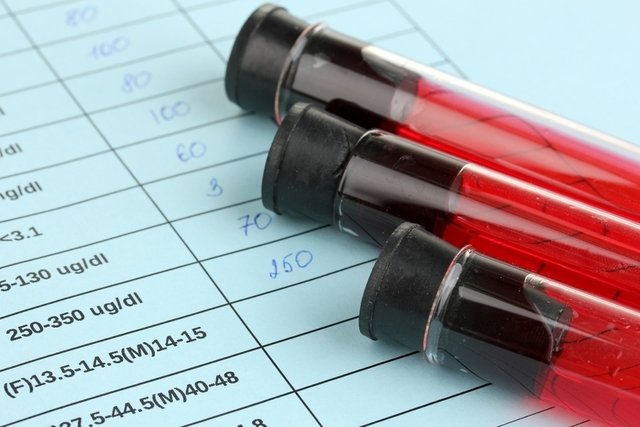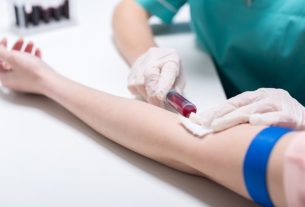The complete blood count is a blood test that evaluates the cells that make up the blood, such as leukocytes or white blood cells, red blood cells, also called red blood cells or erythrocytes, and platelets.
This test is carried out by analyzing a blood sample and, when altered, can be indicative of anemia, inflammation, infections and diseases such as lymphoma or leukemia, for example.
In case of changes in the blood count, especially if symptoms such as weakness or a racing heart appear, it is important to consult the general practitioner so that the blood count can be evaluated, taking into account the results of other tests that may have been requested, and, therefore, be carried out. diagnosis and the most appropriate treatment is initiated.

What is it for
The blood count serves to aid diagnosis and monitor the evolution of diseases that cause changes in the blood, such as:
- anemias;
- Bone marrow disorders;
- Bacterial, fungal or viral infections;
- Inflammations;
- Cancer, especially leukemia or lymphoma;
- Changes in platelets, such as their increase (plateletosis) or decrease (thrombocytopenia);
- Monitoring situations that may compromise the functioning of the bone marrow, such as during chemotherapy, for example.
Furthermore, the blood count is useful for monitoring chronic diseases that can lead to anemia, such as kidney failure, rheumatoid arthritis, heart failure or lung disease, for example.
How is done
The complete blood count is made from a blood sample collected in the laboratory, which is analyzed using equipment that has the function of counting, evaluating and classifying blood cells automatically.
However, even with the result provided by the equipment, a microscopic analysis must be carried out, called differential count in a blood smear, which is carried out by a professional qualified in Clinical Analysis.
This analysis consists of differentiating leukocytes and visualizing specific structures within blood cells. Furthermore, the count also allows the identification of immature cells, which can assist in the diagnosis of leukemia, for example.
Does a complete blood count need to fast?
It is not necessary to fast before the complete blood count. However, it is recommended that you refrain from drinking alcohol for 48 hours before the exam. Furthermore, it is also important to avoid physical activity in the previous 24 hours, as it can also alter the result.
How to interpret the blood count
To interpret the blood count, the doctor normally takes into account the symptoms presented by the person, if any, the results of other requested tests and observes the results of the blood count, looking for changes in its values. Better understand the blood count reference values.
How to know if your blood count is normal
To find out if your blood count is normal, enter your test results below:
What do changes in blood count mean?
Changes in the blood count have different meanings depending on the cells involved:
1. Red blood cells, red blood cells or erythrocytes
The erythrogram is the part of the blood count that evaluates red blood cells, red blood cells, also known as erythrocytes. Changes in the erythrogram may indicate:
In addition to the number of red blood cells, this part of the blood count also analyzes their characteristics, which are also important in interpreting the test. The characteristics of red blood cells normally analyzed in the blood count are:
- MCV or Mean Corpuscular Volume: measures the size of red blood cells, which may be increased in some types of anemia, such as vitamin B12 or folic acid deficiency, alcoholism or changes in the bone marrow. If it is reduced, it may indicate anemia due to iron deficiency or genetic origin, such as Thalassemia, for example. Learn more about VCM;
- HCM or Mean Corpuscular Hemoglobin: indicates the total hemoglobin concentration by analyzing the size and color of the red blood cell. See what high and low HCM means;
- CHCM (mean corpuscular hemoglobin concentration): demonstrates the concentration of hemoglobin per red blood cell, which is normally reduced in anemia, this situation being called hypochromia. Find out more about CHCM;
- DMV (Amplitude of distribution of red blood cells): it is an index that indicates the percentage of variation in size between the red blood cells in a blood sample, therefore, if there are red blood cells of varying sizes in the sample, the test may be altered, which can be a clue to the onset of anemia due to iron or vitamin deficiency, for example, and its reference values are between 10 and 15%. Learn more about RDW.
Therefore, to correctly interpret the meaning of changes in this part of the blood count, it is important to take into account the changes identified in each value.
2. White blood cells (Leukocytes)
The leukogram is an important test to check a person’s immunity and how the body is reacting to situations, such as infections and inflammations, for example.
When the concentration of leukocytes is elevated, the situation is called leukocytosis, and the opposite, leukopenia. See how to understand the white blood cell count result.
Changes in the leukocyte count vary according to the types of leukocytes affected and may indicate:
3. Platelets
Platelets are, in fact, fragments of cells that are very important as they are responsible for starting the clotting process. The normal value of platelets should be between 150,000 and 450,000/mm³ of blood.
Elevated platelets are worrying as they can cause blood clots and thrombi, with a risk of thrombosis and pulmonary embolism, for example. When they are reduced, they can increase the risk of bleeding. Find out what the causes are and what to do if you have low platelets.

Sign up for our newsletter and stay up to date with exclusive news
that can transform your routine!
Warning: Undefined array key "title" in /home/storelat/public_html/wp-content/plugins/link-whisper-premium/templates/frontend/related-posts.php on line 12
Warning: Undefined array key "title_tag" in /home/storelat/public_html/wp-content/plugins/link-whisper-premium/templates/frontend/related-posts.php on line 13



